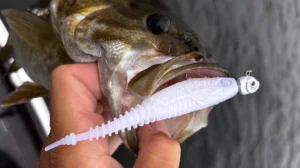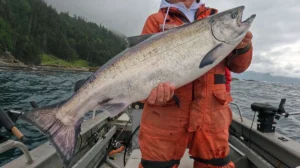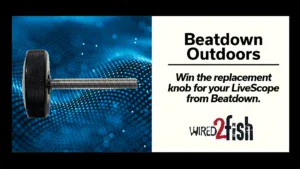Is it possible to use forward-facing sonar without selling your soul? Perhaps that’s a little bit of a goading way to put it, but that is in essence the question I have been asking myself these last couple of years. The vast majority of anglers have dug their heels in on this topic, one way or the other. They either want to use it all the time with no restrictions, or they want the tech in its entirety banned from tournaments and made illegal.
But I find myself still riding the fence. Is there a place to land in the middle? Is that too much to ask in the partisan and polarizing modern world? Here’s what I think.
My History With FFS
I have just enough experience with FFS to be dangerous with it. I don’t currently have a FFS system on my boat, but I actually had a Garmin unit with Panoptix (the company’s early LIVE imaging) on it for a year or so 7 years ago, before hardly anyone else knew about it. Panoptix was rudimentary compared to today’s equipment, but still marvelously effective and astonishingly advanced at the time.
I used Panoptix for about 8 months, but found my interest in the entire sport of bass fishing waning in that season of my life. That’s another story for another day. I mention it only to assure you my experience with this tech stretches farther back than most. I sold the graph and the boat it was on and stepped away from the sport for a year or two, only fishing locally with my dad on occasion.
How I Got Here
A couple years later when I awoke from my slumber, FFS was all the rage. Its use was becoming more and more prevalent until it recently reached its fever pitch and became something that dozens of top-level touring pros relied primarily, if not solely on, to catch their fish. In just a few years, this niche technology had become mainstream and had impacted many a leaderboard at every level of competitive bass fishing.
It became evident a couple of years ago that many of the top finishers were garnering part or most of their success from FFS. This tech was dominating. This realization, and subsequent uproar from anglers not wanting to adopt the new way of doing things, led to tournament organizations assessing the situation and instituting new rules to throttle the effectiveness of FFS, and some banning it altogether. Some of these rules have since been refined even further in an attempt to completely recalibrate competitive fishing.
How Did This Affect My Decision?
Somehow, knowing that there are guardrails at some level helps me feel like I won’t be as tempted to solely lean on FFS completely, if I decide to use it more often. I have no aspiration to fish on any professional fishing trail. But, knowing that it’s not an all-out arms race at that level helps settle the uneasiness of thinking I need to have the latest and greatest of everything and do it just like those guys.
This is something that affects a lot of us subconsciously. Take outboard motors, for instance. Not many of us local anglers aspire to have a 300 HP engine, but many of us want a 250. And, whether we realise it or not, that’s because 250 HP is the max horsepower allowed by BASS, MLF, and NPFL.
My point, I didn’t really like the idea of FFS when it was a free for all on the national trails. I didn’t like watching a guy fish who had used it exclusively; finding it somewhat boring. I didn’t want my fishing to look like that, to turn into that. I still wanted to throw my frog and my spinnerbait, and if I didn’t catch them, fine. The pros don’t have that luxury though, they’ve got to catch them, and thus I don’t fault them for doing what they have to do within the rules.
And I don’t have any doubt that going all-in on FFS would make me a more effective angler. But I don’t really care to be that good, because I would lose my mind in the process. Part of what I like about going fishing, is the fishing.
I just want to cast, let the anticipation build, and let the mystery of what’s under the surface remain unknown – right up until the bass explodes on my bait. If I know a fish is right there in front of me, and I spend 30 minutes trying to get it to bite and come up empty-handed, I will lose it. I get enough of that for the whole year in just a couple weeks of bed fishing in the spring.
It may sound as though I’m meandering a bit, and that’s a fair assessment. But you must realize this is a complex subject. I’ve been quite conflicted on whether or not I want to use FFS for years now, on whether or not I should. And on how that decision will affect not only how I fish but the type of fishing content I put out to the world through articles I write and videos I publish. It almost feels like I have a moral obligation to help steer the ship a bit in regards to the use of forward-facing sonar. And so, it’s taken some time to reach a decision. But here it is.
To FFS Or Not To FFS

I believe there is a way to incorporate FFS into my fishing to enhance it without it taking over, and that is what I intend to do. I do not believe FFS is the devil, but I don’t want to sell my soul to it all the same. My dad has had a FFS unit on his boat since he bought it a few years ago. I have played around with it when I’m with him and it has already cost me quite a bit of fishing time, as I clumsily stumbled around trying to snipe a bass that may very well have been a carp the whole time.
But there have been times, too, when I’m fishing down the bank and pan the transducer around to suddenly find a rock outcropping that I didn’t know existed on a bluff that I had fished a hundred times before. And more than once these tips from the transducer have resulted in a critical fish catch in a tournament. So, in reality, I have already been testing the waters of using this technology, again, off and on for nearly 8 years.
Given the new rules in place at the top of the competitive fishing world, and how I’m confident those decisions will have trickle down impacts to the sport as a whole, I feel comfortable leaning in a bit and embracing FFS as a part of what I do. I don’t want it to take over, but I’ve already seen it benefit my style of fishing too many times to ignore its usefulness. I like to fish shallow, typically around cover. I have found brush-piles, boulders, laydowns, ditches, dropoffs, and other cover and structure that I would have never known existed without FFS.
I’m comfortable being a proponent of using this tech, within reason. Buy a reasonably priced graph with a moderate-size screen if you want to give this a try. Lowrance has a $1,000 Eagle Eye unit that has FFS. I haven’t tested it out yet, but I have plans to soon. For the way I’m talking about using this tech — to spot cover and structure — the 9-inch display on that unit will be plenty. You don’t really need the giant graphs unless you’re chasing single fish around out in the open. Don’t let the tech overwhelm you, and certainly don’t let the idea of having to have it send you into debt.
I’m working to secure a 10-inch unit soon to go on my boat that has forward-facing capabilities. I plan to use this unit to make myself more effective at what I’ve spent 30-plus years getting good at. If I happen to see a fish swimming off to my left, I’m sure I’ll fling a cast or two in its direction. But, unless that proves to be super effective super quick, I’ll circle back to the task at hand and let the graph amplify my peripheral vision as I fish down the bank.
I hold no ill will against anyone who wants to go all in on it, either. That’s just not the path I want to take. I want to do what I want to do, I just want to be able to do it better. And I do believe that incorporating forward-facing sonar into what I’m already doing is the way to do that.














